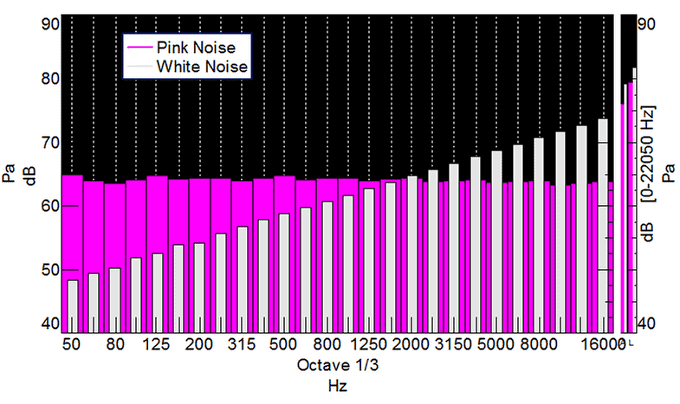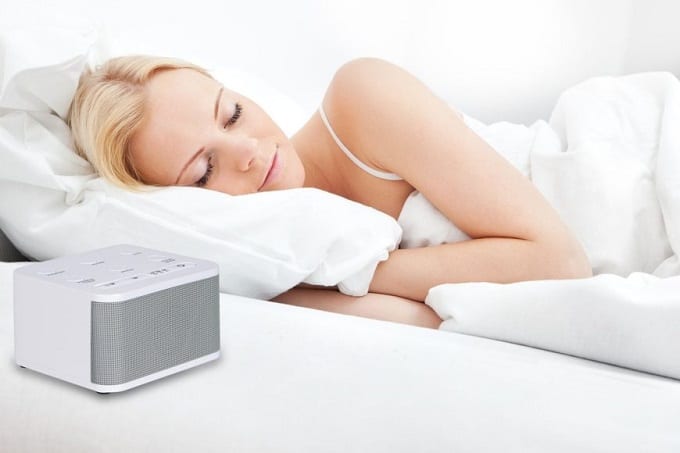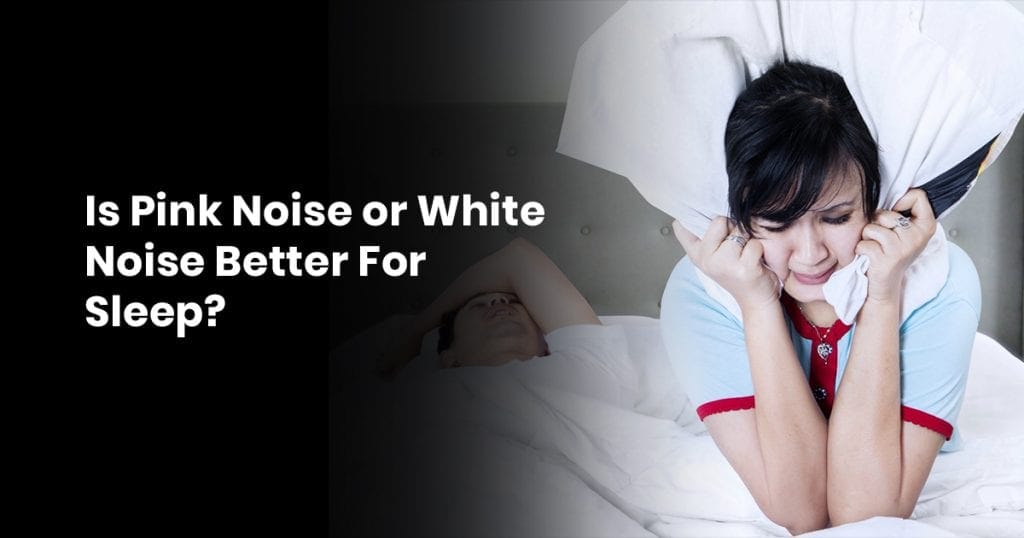Do you have a hard time falling asleep?
Well, you’re not alone. Lack of sleep makes focusing at work or school a challenge. It may also have a negative impact on your physical and mental health over time.
If your mind is always racing at bedtime, you may benefit from using a white or pink noise sound machine.
Is pink noise or white noise better for sleep?
White noise sound machines have been tried, tested, and proven to help many people drift into a restful sleep. Lately, though, there’s lots of talk about pink noise sound machines as well. So what’s the difference?
Pink is actually the new black – or the new white. Pink noise is basically a color of sound, like white noise.
Although both colors contain all of the frequencies that we humans hear, pink noise is perceived as “flat” or “even” and white noise is perceived as “static.”
The question of which sound is better for sleep will often depend on the individual and what works for one may not work for the other.
Pink noise like white noise is random noise; however, pink noise’s volume decreases by 3db per octave, which can be compared to thunder.
With pink noise, higher frequencies hold less spectral power than low frequencies. Pink noise is known to induce deep sleep and drastically improve memory in older people.
Pink Noise vs. White Noise
The energy of the sound signal determines the color of noise. It specifically depends on how the energy is dispensed over different frequencies or the speed of sound.
Although pink noise is made up of all the frequencies we hear, the energy is not distributed equally across them.
Pink noise, when compared to white noise, is more intense, but at lower frequencies, which creates a deep sound.
Examples of pink noise include the sound of steady rain, rustling leaves, wind, and heartbeats.
Pink noise will ultimately always sound even or flat to the human ear.
Your brain continues to recognize, and process sounds even while you sleep, and different noises affect how well you sleep.
While some sounds like cars honking and dogs barking stimulate your brain and keep you awake, other noises can relax your brain and induce restful sleep.
Noise sleep aids are sleep-inducing sounds. You can listen to them on your smartphone, computer, or white noise machine.
According to research, pink noise promotes deep sleep, which makes you feel refreshed in the morning and supports memory.
Sound has various colors. These sonic hues or color noises as they are commonly referred to depend on the distribution and intensity of energy. Here are some color noises below:
- Pink Noise: Pink noise may be more profound than white noise; however, it is not as deep as brown noise.
- White Noise: White noise is made up of audible frequencies. Unlike the energy in pink noise, the energy in white noise is equally dispensed across these frequencies. The result is a steady, humming sound. Examples of white noise include tv or radio static, fan noises, radiator sounds, and a humming conditioner. White noise is capable of masking loud or annoying sounds because it contains all frequencies. These loud noises often stimulate your brain and hence keep you up, which is why white noise is recommended for sleeping disorders and difficulties.
- Brown Noise: Red noise or brown noise as it is often referred to has higher energy at lower frequencies. So ultimately, it’s deeper than both white and pink noise. Some examples of brown noise sounds include strong waterfalls, thunder, and low roaring. Brown noise differs significantly to white noise, although it sounds the same to the human ear. The research to support the effects of brown noise for sleep is limited, but according to anecdotal evidence, the fact that brown noise is deep can indeed induce sleep and relaxation.
- Black Noise: Black noise is actually an informal term that describes a total absence of sound. It basically refers to complete and utter silence or silence with random bits of noise. It may be quite a challenge to find absolute silence, yet some people can only enjoy rest and relaxation when they have it.
What is a pink noise machine?

Pink noise has, in recent years, become the most listened to sleep sound.
This is due to the evidence supporting claims that pink noise indeed improves memory and increases time spent in a deep sleep.
Pink noise machines have been developed to deliver these ambient noises reminiscent of pink noise in order to calm and induce deep sleep.
While some sleep machines may only generate white noise, others send out pink noise as well. Now pink noise is said to be better for some people as the frequencies are more balanced.
Patients who fell asleep to pink noise showed reduced brain wave activity and had must more restful and deeper sleep.
So ultimately pink noise sound machines generate professional-quality audio from an enabled device using Bluetooth or a micro SD card which is pre-loaded with pink noise sounds.
All sound machines have built-in volume control and sleep sounds for babies.
The pink noise sound machines can also be operated as a speakerphone via the integrated microphone. Some are battery operated while others are fully rechargeable.
Difference between pink and white noise machine
There is no aesthetic or physical difference between pink and white noise machines. Ultimately they all have similar control settings and so on.
However, the actual difference lies in the sounds or frequencies that pink and white noise machines generate.
White Noise
Since white noise is equal energy for every frequency, it has a lot to do with energy. Equal amounts of energy represent all frequencies across the human audible spectrum.
Pink noise, on the other hand, is all about octaves and has equal energy per octave.
How the human ear hears sounds and music is through octave bands. Those with especially sensitive hearing frequently hear pitches within octaves.
Pink Noise
Most think often think that oink noise is equalized or calibrated to the human ear’s response; however, this is not correct.
It is, however, adjusted to how the human ear is designed to hear, which is named in octave bands.
Pink is Hearing
So pink noise is imply calibrated to how humans normally hear. It’s actually all related to math, and each time the frequency doubles, humans hear that as an octave.
This is also why audio equipment is calibrated to pink noise. In a nutshell, octave bands are easier on our hearing mechanism.
Pink Noise and White Noise

Pink and white noise is about energy distribution. However, while white noise is energy per frequency, pink noise is energy per octave.
Pink noise represents the energy divisions in which the human hearing functions. This is because human hearing is adjusted to listening for octaves.
White noise is structurally more accurate and therefore suitable for testing electronic equipment performance parameters.
Pink noise is louder, but at the lower end of the spectrum and softer at the higher end. An example of real-world pink noise would be light to medium rainfall.
White noise is widely spread across the sound spectrum, including low-frequency, midrange, and high-frequency sounds.
You may compare it to the sound of a waterfall hitting different surfaces and falling at various speeds.
White noise has proven to be effective in helping lots of people drift into a peaceful night’s sleep. So why do you need pink noise?
Pink noise is proven to be a more balanced, steady mix of high and low frequencies. The name ‘pink noise” comes about because the light of the same frequency appears pink.
Pink noise is also much more pleasant to listen to and can be compared to the sound rustling leaves as opposed to white noise, which is more like a constant drone.
The Benefits of Pink Noise
Lots of studies have shown that pink noise can help you achieve a better quality of sleep.
While some studies have proved that deep sleep patterns improve as pink noise is played intermittently throughout the night, others have shown that it actually improves memory.
This is due to the fact that slow-wave sleep was encouraged while pink noised played. This type of sleep activity promotes the brain’s memory function.
Pink noise is also used to promote concentration when played in office environments.
So the next time you are tempted to queue up your air conditioner before bedtime, listen instead to the sound of gentle rain.
It is relaxing and even more so than the sound of an air-conditioner. This sound and other natural ones such as the rustling of leaves and flowing water will keep you asleep all through the night.
When you awake, you will feel refreshed and have increased concentration and memory.
When should you opt for pink and when for white?

If you are a particularly light sleeper, someone might have suggested white noise to you.
White noise is background noise of a specific frequency that helps to break up the silence settles your mind as you listen to it.
Pink noise also exists, and more people are starting to enjoy its benefits in recent years. Pink noise may indeed help with your sleep issues, especially where white noise has failed to work.
White noise causes a sound masking effect. So when you are asleep, the sound of a dog barking or a partner snoring will not wake you up.
White noise effectively masks these sounds, so it doesn’t interrupt your sleep.
So who should use white noise?
Some people find white noise to be too harsh. Due to this reason, pink noise with it’s lower pitch is a popular alternative.
Pink noise has a deeper and more gentle sound, so it’s suitable for those with sensitive hearing.
White noise does, however, offer the following benefits:
- Improved concentration
- Sound cancellation and masking
- Sleep promotion
So if you want to know whether white noise is right for you, ask yourself whether you enjoy the sound of television static, light rain or a hissing stream.
If you answered yes to these questions, then white noise will offer you a great sleep.
Pink noise is often compared to the sound of rushing water, rustling leaves, or heavy rain.
While these sounds offer much of the benefits that white noise does, such as eliminating background sounds, it is more relaxing for lots of people.
Pink noise has other benefits, too, such as:
- Improved focus
- Better and deeper sleep
- Alleviated headaches
- Soothes babies and small children
Both pink and white noise has proven beneficial in helping people fall off to sleep and stay asleep.
If white noise works for then, there’s no reason not to make use of it. Alternatively, if the soothing effects of pink noise work for you, then go ahead and use it.
Related Questions
What are the different colors of noise?
Three significant noise “colors” are used to keep background noise at bay, white, pink, and brown noise. However, white noise is the most well-known of them all.
What are some benefits of using a sound machine to sleep?
Sound machines help you relax and enjoy a deeper sleep. They also increase your concentration and memory, block out office distractions, and boosts productivity.
Is it safe to listen to color noises?
Yes, these noises, irrespective of whether it is white, pink or brown are essential that – noise.
These sounds have a particular pattern that masks background sounds and has a wealth of other benefits. So they are completely safe to listen to.

